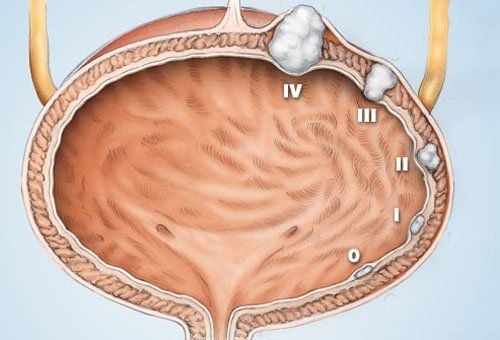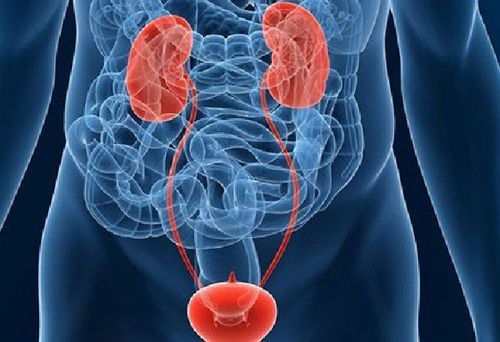This is an automatically translated article.
Bladder cancer is one of the most dangerous and life-threatening cancers. However, bladder cancer is curable if detected and treated early. Like other cancers, bladder cancer is also divided into several stages. Learn more about these stages in the article below.1. What is bladder cancer?
The bladder is a hollow organ located in the lower abdomen whose main job is to store urine from the kidneys. Urine from the kidneys is carried into the bladder through a tube called a ureter. The outer layer of the bladder wall is a muscular layer, when the bladder is full of urine, this muscle layer contracts to expel urine through another small tube called the urethra.Bladder cancer usually starts from the cells lining the inside of the bladder, the size of the tumor will be large or small depending on the stage of the cancer.
Bladder cancer has 3 types:
Transitional cell cancer: This is the most common form of bladder cancer, the incidence rate is 90%. Transitional cell cancer occurs in the cells that line the inside of the bladder (transitional cells contract when the bladder is empty and relax when the bladder is full); Squamous cell carcinoma: About 8% of bladder cancers are squamous cell carcinomas. Normally, squamous cells appear in the bladder in response to irritation and infection. If the patient's body is infected with a parasite that can cause these squamous cells to develop into cancer; Adenocarcinoma: This is the rarest form of bladder cancer, accounting for only 2%. It starts in the cells that make mucus-secreting glands inside the bladder. Most bladder cancers are diagnosed at an early stage when it is still treatable. However, even in the early stages, bladder cancer has a very high chance of recurrence. Therefore, people treated after bladder cancer should have follow-up testing to detect cancer recurrence many years after stopping treatment.
2. Causes of Bladder Cancer
The cause of bladder cancer is still unknown.It is often related to factors such as:
Exposure to certain chemicals that can cause cancer: This can happen through: Occupational exposure to aniline dyes in rubber manufacturing, textile, paint, leather, metal and hair dye industries;
Chemotherapy with drugs of the group cyclophosphamide;
Long-term use of some Chinese herbs and Phenacetin group pain relievers.
Smoke;

Ung thư bàng quang do hút thuốc lá
3. Bladder Cancer Symptoms
Common symptoms of bladder cancer include:Blood in the urine (pink-red urine); Frequent urination or inability to hold urine; Pain when urinating; Back pain or pubic pain.
4. Stages of Bladder Cancer
Once bladder cancer is confirmed, the patient may be ordered by the doctor to do some additional tests to determine the extent, or stage, of the cancer. These tests include:CT scan; Magnetic resonance imaging (MRI); Bone scan (bone scan); Chest X-ray. Stages of bladder cancer include:
Stage 0 (Early bladder cancer) This is the superficial stage of cancer, also known as cancer in situ. Symptoms of the disease at this time almost do not manifest outwardly; Cancer cells only occur on the surface of the bladder wall with very small size, have not invaded the lymph nodes or connective tissues, bladder muscles; Detecting the disease at this stage will have a 98% chance of a complete cure. When bladder cancer is in stage 0, doctors can remove the tumor and still keep the bladder, but the recurrence rate remains high. Stage 1 This is stage where the cancer occurs only on the inner surface of the bladder and is larger in size. Compared to the bladder cancer stages, this is also the stage with the faintest signs; At this stage, bladder cancer may have grown to the connective tissue under the bladder lining but has not invaded the wall muscles, lymph nodes or nearby organs; More than 88% of patients diagnosed at this stage can live for more than 5 years.
Stage 2 This is when the cancer has invaded the bladder wall but has not invaded the tissue around the bladder as well as lymph nodes and distant organs; If the disease is detected at this stage, the patient's chance of survival is about 63%. Stage 3 At this stage, cancer cells have grown through the bladder wall into surrounding tissues. In male patients, the tumor may spread to the prostate gland, in women it may be the cervix or vagina. In other cases, cancer cells may have spread to pelvic lymph nodes but have not yet spread to distant organs.

Please dial HOTLINE for more information or register for an appointment HERE. Download MyVinmec app to make appointments faster and to manage your bookings easily.













